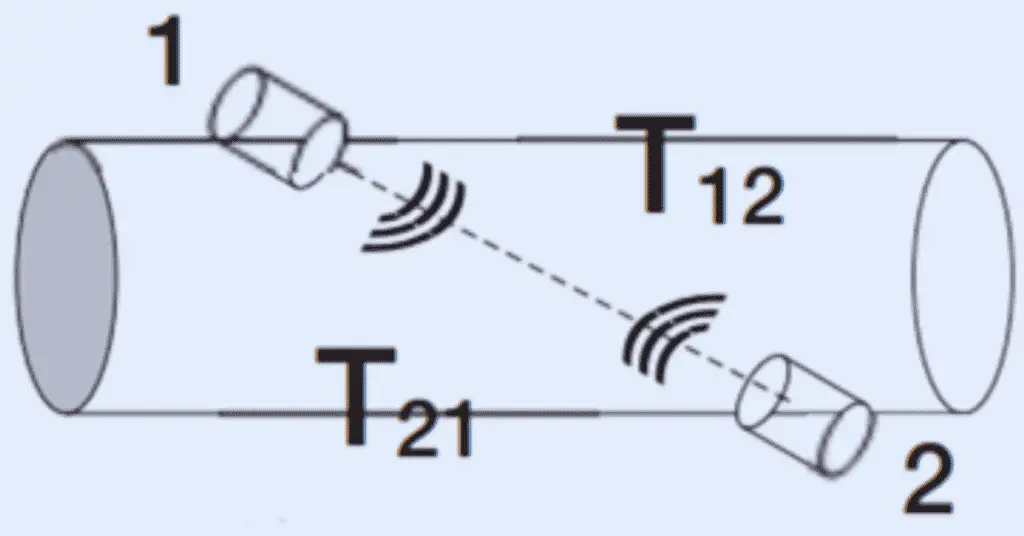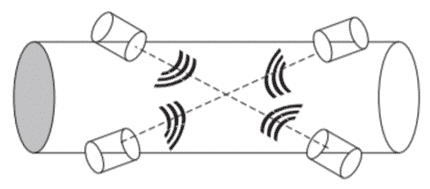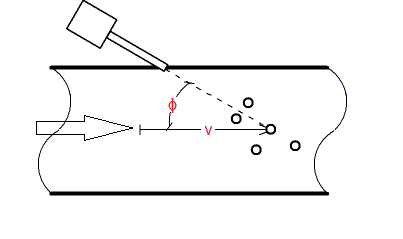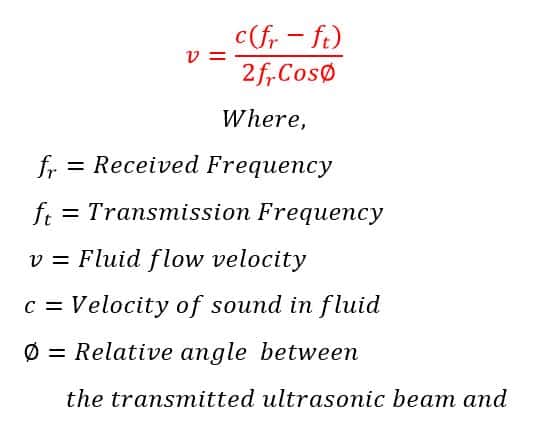Ultrasonic type flow meter is used widely for measuring accurate volumetric flow. Like a magnetic flow meter, an ultrasonic flow meter also does not create a hindrance to flow, and hence there is no pressure drop in the fluid passing through the line.
How does an ultrasonic flow meter work?
Two types of Ultrasonic flow meters are available. 1st works on the principle of the famous Doppler effect and 2nd works on the time transit principle. The 2 methods are available because the fluid can be clear or not clear also. Let us see both types in detail.
1. Time Transit Ultrasonic Flow Meter
Time transit ultrasonic flow meter has wide application in flow measurement. The working of this type of flow meter is very simple. Ultrasonic waves working on-time transit principle are available in 2 different configurations.
- Having 2 wave trans receivers or more pairs of trans receivers
- Clamp-on mounted ultrasonic flow meter
a. Having 2 wave trans receivers or more pairs of trans receivers
In this method, 2 trans receivers are installed in line as shown below figure.

A trans receiver is a simple device that can send as well as receive the signals (waves in our case). At a time 1st trans receiver will send ultrasonic waves and 2nd trans receiver will receive them. The flow meter processor calculates the time in between this process. Now the 2nd trans receiver will send ultrasonic waves and the 1st trans receiver will receive them. and then the processor of the flow meter calculates the time.
If the flow is from trans receiver 1 side to trans receiver 2 then the time taken for the ultrasonic waves to go from trans receiver 1 to trans receiver 2 will be less as compared to the time taken by ultrasonic waves to go from trans receiver 2 to trans receiver 1. The processor takes these both times. and it calculates the flow of the fluid passing through the pipe.
The number of trans receivers provides the measurement accuracy. Therefore, for getting more measurement accuracy, more numbers of trans receivers are a must. As shown in the below image, the 2 pairs of trans receivers are used here. Both these pairs work similarly to the working of the single pair discussed above.

This increases the accuracy of the system as the ultrasonic flow meter averages the readings obtained from both pairs.
b. Clamp-on mounted ultrasonic flow meter
In this type of flow meter, the external sensors are mounted on the pipe. Hence the name is clamp-on meters. The principle of working is the same as that of the transit time ultrasonic flow meter. The only challenge here is that we should know the pipe’s thickness on which we need to mount this meter. This meter is best suitable when there is a need for temporary measurement.
2. Doppler Effect Ultrasonic Flow Meter
In the doppler effect ultrasonic flow meter, the ultrasonic waves are sent to the pipe. The waves are reflected back from any bubbles or particles in fluids. This reflected wave has a frequency shift. This change in frequency or say frequency shift is due to Doppler Effect.

For calculating the velocity of the fluid, we use the following formula:

The only requirement for this method to measure the flow is that there should be some reflecting material or particles in the fluid. Any fluid does not have a steady flow of bubbles or particles. Hence, we will get variations in flow for a given amount of fluid passing. This is the major limitation of the doppler effect ultrasonic flow transmitter.
Applications of ultrasonic flow meter
- For measuring the flow of dirty liquids or wastewater
- For measuring the flow of some chemicals which need high purity (because this is not a contact type flow meter)
- For measuring the flow of fluids having solid particles
- For measuring the flow of fluids having bubbles
Advantages
- Ultrasonic flow meters are the best alternatives for magnetic flow meters. This is because magnetic flow meters need a minimum conductivity to measure flow while ultrasonic flow meters do not have this kind of limitation.
- Ultrasonic flow meters can also work for dirty liquids and also for slurries.
- Ultrasonic flow meters do not have any moving parts; hence, they do not induce any pressure loss in the flowing fluid.
- Because of no moving parts, less maintenance is needed.
- Ultrasonic flow meters are bi-directional flow measuring devices.
- Clamp-on ultrasonic flow meters can be installed without creating any process disturbance.
Limitations of Ultrasonic flow meters
- Ultrasonic flow meters are not suitable for fluids having high turbulent flow.
- Ultrasonic flow meters are quite expensive compared to other flow meters.
- Ultrasonic flow meter accuracy is dependent on the temperature of the fluid flowing also. Because the wave’s speed changes as temperature changes.